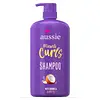What's inside
What's inside
 Key Ingredients
Key Ingredients

No key ingredients
 Benefits
Benefits

 Concerns
Concerns

 Ingredients Side-by-side
Ingredients Side-by-side

Water
Skin ConditioningSodium Lauryl Sulfate
CleansingSodium Laureth Sulfate
CleansingCocamidopropyl Betaine
CleansingGlycol Distearate
EmollientDimethicone
EmollientSimmondsia Chinensis Seed Oil
EmollientCocos Nucifera Oil
MaskingParfum
MaskingSodium Citrate
BufferingCocamide Mea
EmulsifyingSodium Xylenesulfonate
Citric Acid
BufferingSodium Benzoate
MaskingSodium Chloride
MaskingTetrasodium EDTA
Guar Hydroxypropyltrimonium Chloride
Skin ConditioningMethylchloroisothiazolinone
PreservativeMethylisothiazolinone
PreservativeCI 19140
Cosmetic ColorantCI 17200
Cosmetic ColorantWater, Sodium Lauryl Sulfate, Sodium Laureth Sulfate, Cocamidopropyl Betaine, Glycol Distearate, Dimethicone, Simmondsia Chinensis Seed Oil, Cocos Nucifera Oil, Parfum, Sodium Citrate, Cocamide Mea, Sodium Xylenesulfonate, Citric Acid, Sodium Benzoate, Sodium Chloride, Tetrasodium EDTA, Guar Hydroxypropyltrimonium Chloride, Methylchloroisothiazolinone, Methylisothiazolinone, CI 19140, CI 17200
Defined Cell Culture Media 2
Skin ConditioningGlycerin
HumectantCaprylic/Capric Triglyceride
MaskingCetearyl Alcohol
EmollientDimethicone
EmollientBehentrimonium Chloride
PreservativeBis-Hydroxy/Methoxy Amodimethicone
Cetyl Alcohol
EmollientParfum
MaskingTrimethylpentanediol/Adipic Acid/Glycerin Crosspolymer
Skin ConditioningPolyquaternium-37
Dipropylene Glycol
HumectantHydroxypropyl Methylcellulose
Emulsion StabilisingRosa Canina Fruit Oil
EmollientTetrasodium EDTA
Tocopherol
AntioxidantMethylchloroisothiazolinone
PreservativeMethylisothiazolinone
PreservativeBenzyl Salicylate
PerfumingLinalool
PerfumingDefined Cell Culture Media 2, Glycerin, Caprylic/Capric Triglyceride, Cetearyl Alcohol, Dimethicone, Behentrimonium Chloride, Bis-Hydroxy/Methoxy Amodimethicone, Cetyl Alcohol, Parfum, Trimethylpentanediol/Adipic Acid/Glycerin Crosspolymer, Polyquaternium-37, Dipropylene Glycol, Hydroxypropyl Methylcellulose, Rosa Canina Fruit Oil, Tetrasodium EDTA, Tocopherol, Methylchloroisothiazolinone, Methylisothiazolinone, Benzyl Salicylate, Linalool
Ingredients Explained
These ingredients are found in both products.
Ingredients higher up in an ingredient list are typically present in a larger amount.
Dimethicone is a type of synthetic silicone created from natural materials such as quartz.
What it does:
Dimethicone comes in different viscosities:
Depending on the viscosity, dimethicone has different properties.
Ingredients lists don't always show which type is used, so we recommend reaching out to the brand if you have questions about the viscosity.
This ingredient is unlikely to cause irritation because it does not get absorbed into skin. However, people with silicone allergies should be careful about using this ingredient.
Note: Dimethicone may contribute to pilling. This is because it is not oil or water soluble, so pilling may occur when layered with products. When mixed with heavy oils in a formula, the outcome is also quite greasy.
Learn more about DimethiconeMCI is a preservative and known skin-irritant. It has anti-bacteria anti-fungal properties.
Studies spanning several decades have shown this ingredient to cause skin irritation and allergies.
MCI is commonly combined with methylisothiazolinone (MI). Other names for this mixture include Kathon CG and Euxyl K 100.
The use of this ingredient varies around the world:
Learn more about MethylchloroisothiazolinoneMI is a preservative and known skin irritant. In the past, MI was used for its ability to prevent bacteria, yeast, and fungi growth in low doses.
Nowadays, you'll most likely see MI combined with Methylchloroisothiazolinone (MCI). Trade names for this combination include Kathon CG or Euxyl K 100.
Since then, numerous studies have shown this ingredient to cause contact dermatitis, or skin irritation.
The use of this ingredient varies around the world:
Learn more about MethylisothiazolinoneParfum is a catch-all term for an ingredient or more that is used to give a scent to products.
Also called "fragrance", this ingredient can be a blend of hundreds of chemicals or plant oils. This means every product with "fragrance" or "parfum" in the ingredients list is a different mixture.
For instance, Habanolide is a proprietary trade name for a specific aroma chemical. When used as a fragrance ingredient in cosmetics, most aroma chemicals fall under the broad labeling category of “FRAGRANCE” or “PARFUM” according to EU and US regulations.
The term 'parfum' or 'fragrance' is not regulated in many countries. In many cases, it is up to the brand to define this term.
For instance, many brands choose to label themselves as "fragrance-free" because they are not using synthetic fragrances. However, their products may still contain ingredients such as essential oils that are considered a fragrance by INCI standards.
One example is Calendula flower extract. Calendula is an essential oil that still imparts a scent or 'fragrance'.
Depending on the blend, the ingredients in the mixture can cause allergies and sensitivities on the skin. Some ingredients that are known EU allergens include linalool and citronellol.
Parfum can also be used to mask or cover an unpleasant scent.
The bottom line is: not all fragrances/parfum/ingredients are created equally. If you are worried about fragrances, we recommend taking a closer look at an ingredient. And of course, we always recommend speaking with a professional.
Learn more about ParfumTetrasodium EDTA is the salt formed from neutralizing ethylenediamine tetraacetic acid with sodium hydroxide. It is a chelating agent and used to prevent metal ions from binding to other ingredients. This helps keep the product and ingredients stable.
Tetrasodium EDTA comes as a white solid and is soluble in water.